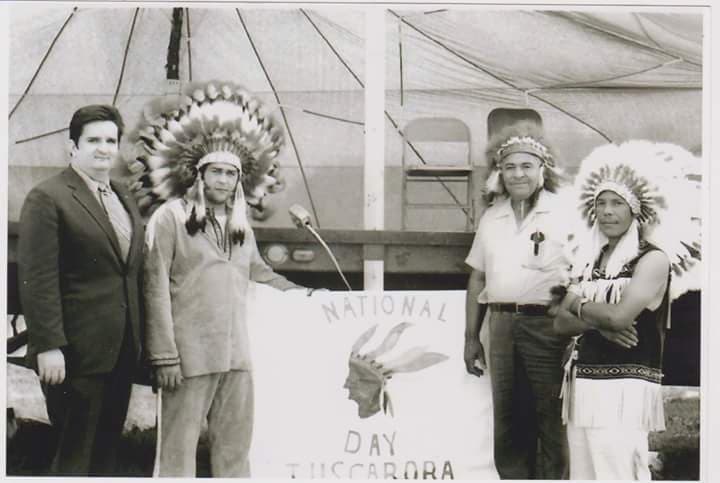Guest Post: Pre-colonial Bison Migrations Uncovers Tuscarora Nation Occupation in Wake County History
The following is a guest post from Donnie Rahnàwakęw McDowell, the Public Relations Officer at the Tuscarora Nation of North Carolina. If you would like to submit community content for The Cary Report, please use our contact form.
The confluence of history, culture, and natural beauty can be witnessed in the relationship between Buffalo Creek in Wake County and the Tuscarora Nation of North Carolina. Deeply rooted in the land, this region bears witness to the intricate connections between the land’s original inhabitants, the Tuscarora Nation, and the modern-day communities that have flourished. By exploring this rich heritage, we can foster a greater understanding of our shared history, promote cultural appreciation, and forge a path toward a more inclusive future.
Buffalo Creek, located in Wake County, has a rich history that dates to pre-colonial times. The creek and its surrounding towns were originally inhabited by various Native American tribes. Like the Occaneechi who relied on its waters and natural resources for sustenance and livelihood, the Tuscarora held influence in the region to control their interests in chief trade routes. With the arrival of European settlers in the 17th and 18th centuries, the region underwent significant changes. The Native American tribes were gradually displaced from their ancestral lands, and the area surrounding Buffalo Creek came under the control of European colonizers. As European settlement expanded, farms and plantations were established along the creek, utilizing its fertile soil for agricultural purposes. This also drove out the buffalo that seasonally migrated to that region of Wake County, creating gaps in the local food stores of the Tuscarora and Occaneechi that occasionally relied on the buffalo.
The Occaneechi were situated at the center of a great trading path known by their name, making the surrounding area very attractive to trade merchants from neighboring tribes, as well as colonial suppliers. Following the decline of the Powhatan Confederacy, the Tuscarora Nation took control of vast lands then absent of Virginia Indians across northern NC and southern Virginia. Decimation from European disease weakened local tribes, giving the more numerous Tuscarora the opportunity to expand trade networks and their land holdings. A declining fur trade led to the increase in sales of rum, shot, and guns among other things that the Tuscarora Nation picked up as a middleman to trade between Piedmont Indian Nations. Tuscarora influence declined at the turn of the 18th century, when Tuscarora dominant regions became of interest to permanent European settlement.
The transplant of European settlements uprooted entire Tuscarora villages across NC, including the lands that would become Wake County. At the same time, raids by colonists and Siouan Indians from South Carolina took hundreds of Tuscarora captives, further depreciating relationships with Tuscarora villages in the southern territories. With European colonization, the Tuscarora and Occaneechi Peoples faced tremendous challenges and pressures for change. Conflict erupted during the Tuscarora War of 1711-1715, leading to displacement and devastating consequences for all who inhabited the Carolina interior. However, it is crucial to acknowledge that the Tuscarora Nation and the Occaneechi People continued to remain in NC following the end of the Tuscarora Wars.
The Occaneechi, a branch of the Saponi, moved toward the lands that would become Orange and Alamance Counties to avoid the confrontations of the Tuscarora Wars and settler raids across the frontier. When the Indian Woods Reservation was established for the ancestors of the Tuscarora Nation, eventually some Saponi requested to seek shelter there in the 1730s. Due to the complications left by the Tuscarora Wars, both the colonial Governments of Virginia and North Carolina had to first approve this request. Within a few decades, hundreds of Tuscaroras and their allies who chose to live among them, would make the choice to seek refuge in uninhabited borderlands. Before the end of the 18th century, a large Tuscarora settlement was in place in the area that would become modern-day Robeson County. A few Saponi families remained with the Tuscarora in Robeson County, intermarrying with core Tuscarora families, and helping to support and defend the settlement along the Drowning Creek.
As the laws in NC evolved and adapted to fit the needs of advancing white settlement and industrialism, the Tuscarora and Occaneechi communities resisted forced assimilation by maintaining their distinct identities. Under intense adversity, the Tuscarora and Occaneechi People continued to remain self-determined. These communities survived the War of American Independence, Indian Removal, the Civil War, and managed to remain visible in state records.
In the present day, Cary, a vibrant town within Wake County, stands as a testament to the resilience and contributions of the Tuscarora Nation and other Native American tribes. The town’s commitment to inclusivity and recognition of indigenous heritage has helped strengthen the bond between the modern community and Native Americans.
Cultural appreciation and collaboration are vital to understanding and honoring the heritage of the Tuscarora Nation and other Native American tribes. Cary and Wake County can take proactive steps to acknowledge and celebrate this shared history. Initiatives such as cultural exchanges, educational programs, and the incorporation of Native American voices in local decision-making can foster mutual respect and understanding.
Buffalo Creek, with its scenic beauty and ecological significance, must be preserved as a shared space for all. By prioritizing environmental conservation efforts, such as water quality monitoring, habitat protection, and responsible development practices, we can ensure that future generations can appreciate the natural wonders that have drawn people to this region for centuries. Acknowledging the presence of the Tuscarora Nation and their tradition of utilizing the area for migratory bison hunting would help ensure the cultural diversity of the region and the relationship to the land is fully understood.
Misconceptions about the Tuscarora Nation caused by assimilation and colonization has created the illusion that the Tuscarora People should not be granted reaffirmation of their aboriginal status. However, research and official documentation proves that the Tuscarora Nation of North Carolina has been previously acknowledged by the State. The relationship between Buffalo Creek, Cary, Wake County, and the Tuscarora Nation offers an opportunity for dialogue, understanding, and unity. By recognizing and embracing the heritage and contributions of the Tuscarora people, we can build a stronger sense of community and create a more inclusive and equitable society.




